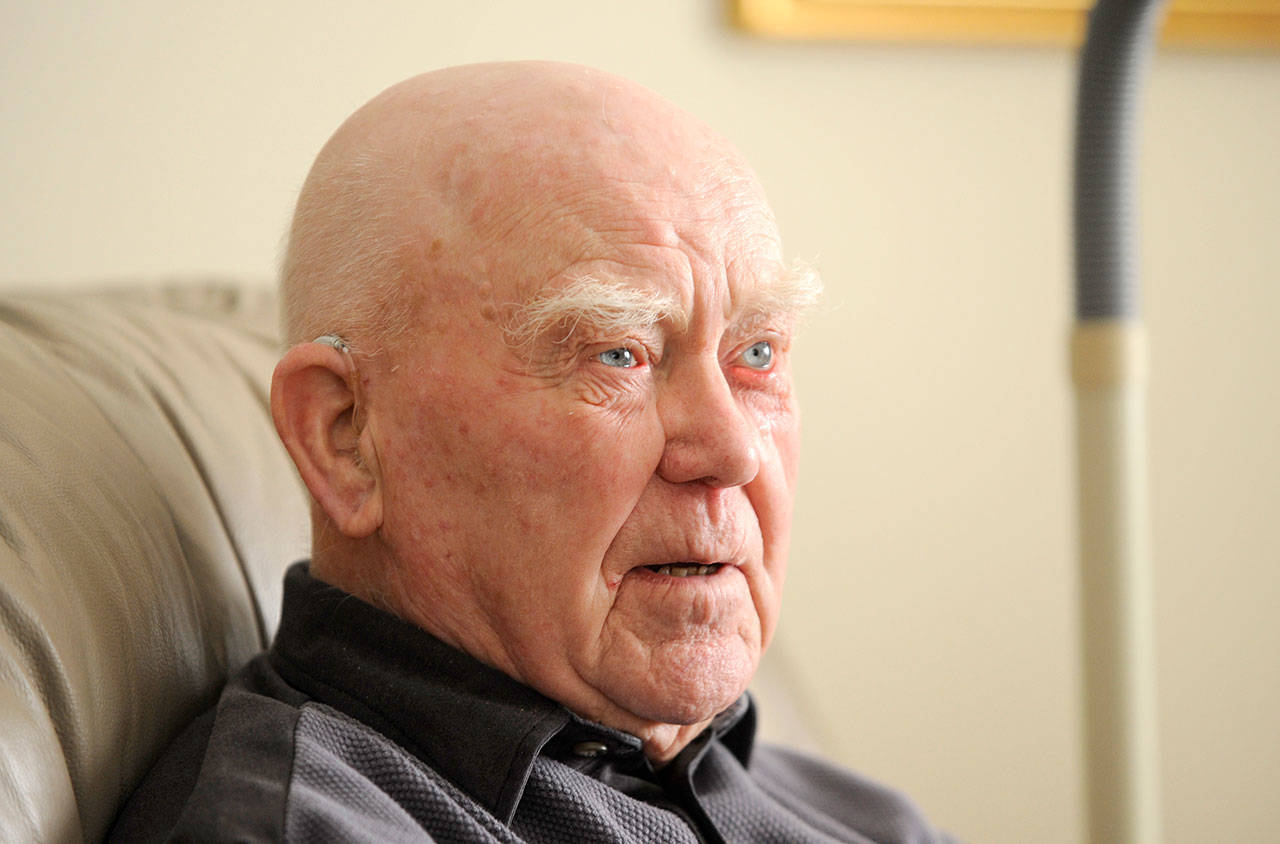A Sequim man who survived the attack on Pearl Harbor — and was a candidate for The Congressional Medal of Honor for his efforts to save the lives of eight men on the USS Oklahoma that day — has died.
Roy D. Carter died on Jan. 3 from age-related causes in his Sequim residence. He was 98.
Carter, who retired from the U.S. Navy at the rank of lieutenant commander, escaped the battleship USS Oklahoma after torpedoes tore through the heart of the ship on Dec. 7, 1941, causing it to tip over and sink in little more than 10 minutes.
Carter, like everyone else on board and in the Pacific fleet, said he had no clue of the incoming Japanese invasion.
While he was three decks below in the carpenter shop, he heard an alert: “Air attack! No Sh–! All hands man your battle stations. Set conditions zed!”
Said Carter, in a 2010 interview: “These were the last words we heard in the damage control section.”
Carter said his battle station was to lock down a watertight door with eight handles and a watertight hatch that could only be opened from the third deck.
Torpedoes hit while Carter locked the door, and the Oklahoma began tipping. He felt the thumps as the bombs barraged the middle of the ship.
“You could feel every impact,” he said. “If there was an explosion sound, I didn’t hear it because it was far from my mind.”
The attack took out the ship’s lights and communications, but the worst part, he recalled, was that by locking down the door he sealed eight quartermasters into their stations below him.
Knowing his only option was to leave, Carter began climbing out on his hands and knees as water and oil drenched him from head to foot. Somehow none of the doors above him had been sealed and he climbed out before the ship turned over and pulled him under.
“If I had taken one more minute and the men above me had closed the watertight hatches, I’d be dead,” Carter recalled.
He later discovered that the eight men below him were saved by his efforts. After the ship flipped, the quartermasters were trapped for 30 hours but were safe from that rising water and oil that the door kept out. They banged and hammered the hull and pipes to let people know they were inside and eventually they were cut free.
“I felt I saved eight guys that day,” Carter said.
All told, 429 souls — Navy men and Marines — lost their life on the USS Oklahoma in the attack.
“I don’t know the amount that were killed by torpedoes but there were a lot who starved to death or drowned while trapped,” he said.
While swimming to a nearby ship, high-altitude bombers dropped bombs within 100 yards but somehow none went off, he said.
Years later, Carter was reintroduced to one of the eight quartermasters, Bud Kennedy, who lived in Port Angeles until his death.
A Navy life
An Iowa boy, Carter was 18 years old when he joined the U.S. Navy. After boot camp, Carter and three buddies from Company 19 were assigned to the battleship USS Oklahoma, which was stationed in Bremerton.
The USS Oklahoma, commissioned in 1916, was a ship Carter called a “technological marvel.”
His first assignment on the USS Oklahoma was swabbing the deck and scraping barnacles while it was dry-docked in Bremerton.
“That was not what I called learning a trade, that or scrubbing the deck,” he said.
“I was making $15 a week at 10 hours a day, six days a week bagging groceries,” Carter said. “When I joined in 1938, I made $21 a month for 24/7-service.”
Eventually Carter was promoted to senior damage control man in the rear portion of the ship.
Following his service on the Oklahoma, he served for three months on the USS Pelias, a submarine support craft, before being offered flight training.
Carter was commissioned as a naval aviator and served on active duty for seven years, mostly in Europe. He flew a B-24 that carried special weapons such as depth charges and torpedoes.
Following his duty, he stayed in the naval reserves for 13 years.
Carter said he was most most proud of receiving his flight wings and being commissioned as an officer.
In 1944, he married Barbara and the couple had three children. After living in a handful of states, Carter retired with his own insurance agency and moved with Barbara (now deceased) in 1986.
With honors
For several years, Carter would visit Naval Base Kitsap at Keyport in Kitsap County for memorial services each Dec. 7. In December 2016, he missed the ceremony in Kitsap County because he was in attendance for 75th anniversary Pearl Harbor ceremonies in Hawaii. (He had attended the 50th and 70th anniversary events in Hawaii as well.)
“I was treated like a king,” said Carter, in an interview shortly after the ceremonies. “Everywhere I went I was saluted, patted on the shoulder and kissed. I must have got a thousand kisses.” And, he admitted, “I like kisses.”
The Honolulu Star-Advisor newspaper interviewed Carter and put his photo and story on the front page of one of its dozens of editions throughout the week.
The following month, U.S. Navy representatives visited Carter and fellow survivor/Sequim resident Bob Rains, bringing them framed American flags that were flown over the USS Arizona Memorial.
Carter also took part in regular meetings of a Pearl Harbor Survivors Group on the Olympic Peninsula until numbers dwindled to single digits.
“At the time of the Pearl Harbor attack, there were 84,000 survivors (while) two years ago, there were 2,500,” Carter noted in 2017.
“Age,” he said, “is like a roll of toilet paper. The closer it gets to the end, the faster it goes.”
Matthew Nash and Mary Powell contributed to this story.



